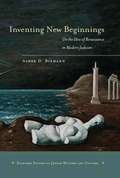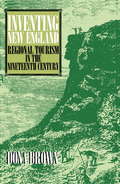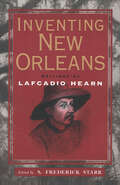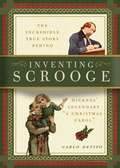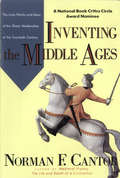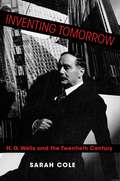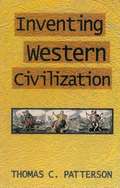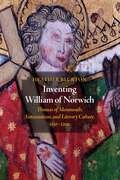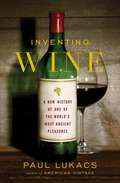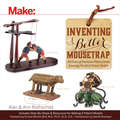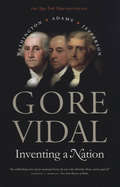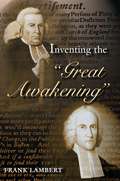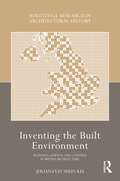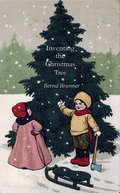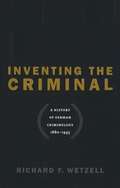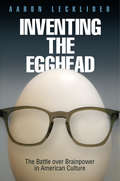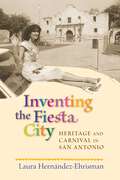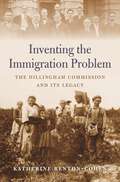- Table View
- List View
Inventing New Beginnings
by Asher D. BiemannBiemann (modern Jewish thought and intellectual history, U. of Virginia) explores the multiple connotations of "renaissance" in relation to the Jewish Renaissance that suffused much of German- speaking Jewry between 1890 and the rise of Nazism in the late 1930s, partly as a backlash to the earlier assimilationist Jewish Enlightenment. Drawing on the thinking of Franz Rosensweig in the New Learning, Mircea Eliade, Hegel, Buber, and other philosophers on the meaning of time and beginnings, he argues that this movement was less a return to traditional Judaism than a renewal of self-awareness and questioning in the encounter with modernity. Annotation ©2009 Book News, Inc. , Portland, OR (booknews. com)
Inventing New England
by Dona BrownQuaint, charming, nostalgic New England: rustic fishing villages, romantic seaside cottages, breathtaking mountain vistas, peaceful rural settings. In Inventing New England, Dona Brown traces the creation of these calendar-page images and describes how tourism as a business emerged and came to shape the landscape, economy, and culture of a region.By the latter nineteenth century, Brown argues, tourism had become an integral part of New England's rural economy, and the short vacation a fixture of middle-class life. Focusing on such meccas as the White Mountains, Martha's Vineyard, Nantucket, coastal Maine, and Vermont, Brown describes how failed port cities, abandoned farms, and even scenery were churned through powerful marketing engines promoting nostalgia. She also examines the irony of an industry that was based on an escape from commerce but served as an engine of industrial development, spawning hotel construction, land speculation, the spread of wage labor, and a vast market for guidebooks and other publications.
Inventing New Orleans: Writings of Lafcadio Hearn
by S. Frederick StarrLafcadio Hearn (1850-1904) prowled the streets of New Orleans from 1877 to 1888 before moving on to a new life and global fame as a chronicler of Japan. Hearn's influence on our perceptions of New Orleans, however, has unjustly remained unknown. In ten years of serving as a correspondent and selling his writing in such periodicals as the New Orleans Daily Item, Times-Democrat, Harper's Weekly, and Scribner's Magazine he crystallized the way Americans view New Orleans and its south Louisiana environs. Hearn was prolific, producing colorful and vivid sketches, vignettes, news articles, essays, translations of French and Spanish literature, book reviews, short stories, and woodblock prints. He haunted the French Quarter to cover such events as the death of Marie Laveau. His descriptions of the seamy side of New Orleans, tainted with voodoo, debauchery, and mystery made a lasting impression on the nation. Denizens of the Crescent City and devotees who flock there for escapades and pleasures will recognize these original tales of corruption, of decay and benign frivolity, and of endless partying. With his writing, Hearn virtually invented the national image of New Orleans as a kind of alternative reality to the United States as a whole. S. Frederick Starr, a leading authority on New Orleans and Louisiana culture, edits the volume, adding an introduction that places Hearn in a social, historical, and literary context. Hearn was sensitive to the unique cultural milieu of New Orleans and Louisiana. During the decade that he spent in New Orleans, Hearn collected songs for the well-known New York music critic Henry Edward Krehbiel and extensively studied Creole French, making valuable and lasting contributions to ethnomusicology and linguistics. Hearn's writings on Japan are famous and have long been available. But Inventing New Orleans: Writings of Lafcadio Hearn brings together a selection of Hearn's nonfiction on New Orleans and Louisiana, creating a previously unavailable sampling. In these pieces Hearn, an Anglo-Greek immigrant who came to America by way of Ireland, is alternately playful, lyrical, and morbid. This gathering also features ten newly discovered sketches. Using his broad stylistic palette, Hearn conjures up a lost New Orleans which later writers such as William Faulkner and Tennessee Williams used to evoke the city as both reality and symbol.
Inventing Scrooge
by Carlo DevitoInventing Scrooge uncovers the real-life inspirations from Charles Dickens' own world that led to the fascinating creation of his most beloved tale: A Christmas Carol.When Charles Dickens conceived the story that would become A Christmas Carol, little did he know that his "ghostly little book" would reinvent the way we keep Christmas. From a graveyard in Edinburgh to the Marshalsea Prison in London to his schoolboy years in Chatham and even his lifelong fascination with dance, so much of Dickens' past and present are woven into the characters and themes of A Christmas Carol. And by understanding the story behind the story, readers will come to embrace the holiday classic all the more. To this day, we look to the Christmas season as a time of warmth and celebration among family, friends, and strangers alike. And every year at Christmas, not only do our lives get better for all the festivity, but we get better, as people. Just like Ebenezer Scrooge.e at a time, was not the way to reach his audience and spread his meaning. It was too piece meal and took too long. It was on this train ride to make this speech that the first ideas came to Dickens to instead, write a story that might advance his cause in a much more effective way. As the train lurched by the engine works at grimy Camden Town, Dickens thoughts must have tripped backwards in his mind, to a time in his youth, when he and his many brothers and sisters lived all jammed into a small home, where the Dickens family led a meager and lean life, as his father struggled with mounting debt. On this eight-hour ride, the seeds for one of his most famous stories came to life - A Christmas Carol. Dickens became obsessed by the story. He wrote that as the tale unfolded he 'wept and laughed, and wept again' and that he 'walked about the black streets of London fifteen or twenty miles many a night when all sober folks had gone to bed.' And almost every aspect of the story came to him as it pulled it from his life. * The nephew, Fred, who comes to see Scrooge is a carefree spirit, who lives what Scrooge considers to be a spendthrift existence, much like Dickens own brother Fred was in real life. * Fred is the son of Scrooge's sister, Fan. In real life, Dickens' favorite and closest sibling was Fran (or Fanny). * Tiny Tim was modeled on Dickens' nephew Henry Burnett Jr., who was small and handicapped. * The Cratchits were the Dickens family of Charles' youth. The Dickens lived in Camden Town, eight to a small, row house, with little money. * Much like Ebernezer Scrooge, Dickens own real life wife Catherine Hogarth, tried to break off their engagement citing that Dickens was more obsessed with making money than spending time with her. Dickens took up all these threads, and wove them into one of the most magical tales of all time. And it all came from this trip to Manchester.
Inventing Stonewall Jackson: A Civil War Hero in History and Memory (Conflicting Worlds: New Dimensions of the American Civil War)
by Wallace HettleHistorians' attempts to understand legendary Confederate General Thomas J. "Stonewall" Jackson have proved uneven at best and often contentious. An occasionally enigmatic and eccentric college professor before the Civil War, Jackson died midway through the conflict, leaving behind no memoirs and relatively few surviving letters or documents. In Inventing Stonewall Jackson, Wallace Hettle offers an innovative and distinctive approach to interpreting Stonewall by examining the lives and agendas of those authors who shape our current understanding of General Jackson.Newspaper reporters, friends, relatives, and fellow soldiers first wrote about Jackson immediately following the Civil War. Most of them, according to Hettle, used portions of their own life stories to frame that of the mythic general. Hettle argues that the legend of Jackson's rise from poverty to power was likely inspired by the rags-to-riches history of his first biographer, Robert Lewis Dabney. Dabney's own successes and Presbyterian beliefs probably shaped his account of Jackson's life as much as any factual research. Many other authors inserted personal values into their stories of Stonewall, perplexing generations of historians and writers.Subsequent biographers contributed their own layers to Jackson's myth and eventually a composite history of the general came to exist in the popular imagination. Later writers, such as the liberal suffragist Mary Johnston, who wrote a novel about Jackson, and the literary critic Allen Tate, who penned a laudatory biography, further shaped Stonewall's myth. As recently as 2003, the film Gods and Generals, which featured Jackson as the key protagonist, affirmed the longevity and power of his image.Impeccable research and nuanced analysis enable Hettle to use American culture and memory to reframe the Stonewall Jackson narrative and provide new ways to understand the long and contended legacy of one of the Civil War's most popular Confederate heroes.
Inventing The Middle Ages
by Norman F. CantorINVENTING THE MIDDLE AGESThe Lives, Works, and Ideas of the Great Medievalists of the Twentieth CenturyIn this ground-breaking work, Norman Cantor explains how our current notion of the Middle Ages-with its vivid images of wars, tournaments, plagues, saints and kings, knights and ladies-was born in the twentieth century. The medieval world was not simply excavated through systematic research. It had to be conceptually created: It had to be invented, and this is the story of that invention. Norman Cantor focuses on the lives and works of twenty of the great medievalists of this century, demonstrating how the events of their lives, and their spiritual and emotional outlooks, influenced their interpretations of the Middle Ages. Cantor makes their scholarship an intensely personal and passionate exercise, full of color and controversy, displaying the strong personalities and creative minds that brought new insights about the past. A revolution in academic method, this book is a breakthrough to a new way of teaching the humanities and historiography, to be enjoyed by student and general public alike. It takes an immense body of learning and transmits it so that readers come away fully informed of the essentials of the subject, perceiving the interconnection of medieval civilization with the culture of the twentieth century and having had a good time while doing it! This is a riveting, entertaining, humorous, and learned read, compulsory for anyone concerned about the past and future of Western civilization.
Inventing Tomorrow: H. G. Wells and the Twentieth Century
by Sarah ColeH. G. Wells played a central role in defining the intellectual, political, and literary character of the twentieth century. A prolific literary innovator, he coined such concepts as “time machine,” “war of the worlds,” and “atomic bomb,” exerting vast influence on popular ideas of time and futurity, progress and decline, and humanity’s place in the universe. Wells was a public intellectual with a worldwide readership. He met with world leaders, including Roosevelt, Lenin, Stalin, and Churchill, and his books were international best-sellers. Yet critics and scholars have largely forgotten his accomplishments or relegated them to genre fiction, overlooking their breadth and diversity.In Inventing Tomorrow, Sarah Cole provides a definitive account of Wells’s work and ideas. She contends that Wells casts new light on modernism and its values: on topics from warfare to science to time, his work resonates both thematically and aesthetically with some of the most ambitious modernists. At the same time, unlike many modernists, Wells believed that literature had a pressing place in public life, and his works reached a wide range of readers. While recognizing Wells’s limitations, Cole offers a new account of his distinctive style as well as his interventions into social and political thought. She illuminates how Wells embodies twentieth-century literature at its most expansive and engaged. An ambitious rethinking of Wells as both writer and thinker, Inventing Tomorrow suggests that he offers a timely model for literature’s moral responsibility to imagine a better global future.
Inventing Western Civilization
by Thomas C. Patterson"In this wonderful book, Thomas Patterson effectively dethrones the concept of 'civilization' as an abstract good, transcending human society. " --Martin Bernal Drawing on his extensive knowledge of early societies, Thomas C. Patterson shows how class, sexism, and racism have been integral to the appearance of "civilized" societies in Western Europe. He lays out clearly and simply how civilization, with its designs of "civilizing" and "being civilized," has been closely tied to the rise of capitalism in Western Europe and the development of social classes.
Inventing William of Norwich: Thomas of Monmouth, Antisemitism, and Literary Culture, 1150–1200 (The Middle Ages Series)
by Heather BlurtonWilliam of Norwich is the name of a young boy purported to have been killed by Jews in or about 1144, thus becoming the victim of the first recorded case of such a ritual murder in Western Europe and a seminal figure in the long history of antisemitism. His story is first told in Thomas of Monmouth's The Life and Miracles of William of Norwich, a work that elaborates the bizarre allegation, invented in twelfth-century England, that Jews kidnapped Christian children and murdered them in memory and mockery of the crucifixion of Christ.In Inventing William of Norwich Heather Blurton resituates Thomas's account by offering the first full analysis of it as a specifically literary work. The second half of the twelfth century was a time of great literary innovation encompassing an efflorescence of saints' lives and historiography, as well as the emergence of vernacular romance, Blurton observes. She examines The Life and Miracles within the framework of these new textual developments and alongside innovations in liturgical and devotional practices to argue that the origin of the ritual murder accusation is imbricated as much in literary culture as it is in the realities of Christian-Jewish relations or the emergence of racially based discourses of antisemitism. Resisting the urge to interpret this first narrative of the blood libel with the hindsight knowledge of later developments, she considers only the period from about 1150-1200. In so doing, Blurton redirects critical attention away from the social and economic history of the ritual murder accusation to the textual genres and tastes that shaped its forms and themes and provided its immediate context of reception. Thomas of Monmouth's narrative in particular, and the ritual murder accusation more generally, were strongly shaped by literary convention.
Inventing Wine: A New History of One of the World's Most Ancient Pleasures
by Paul LukacsThe story of how wine, as enjoyed by millions of people today, came to be. Drinking wine can be traced back 8,000 years, yet the wines we drink today are radically different from those made in earlier eras. While its basic chemistry remains largely the same, wine's social roles have changed fundamentally, being invented and reinvented many times over many centuries. In Inventing Wine, Paul Lukacs tells the enticing story of wine's transformation from a source of spiritual and bodily nourishment to a foodstuff valued for the wide array of pleasures it can provide. He chronicles how the prototypes of contemporary wines first emerged when people began to have options of what to drink, and he demonstrates that people selected wine for dramatically different reasons than those expressed when doing so was a necessity rather than a choice. During wine's long history, men and women imbued wine with different cultural meanings and invented different cultural roles for it to play. The power of such invention belonged both to those drinking wine and to those producing it. These included tastemakers like the medieval Cistercian monks of Burgundy who first thought of place as an important aspect of wine's identity; nineteenth-century writers such as Grimod de la Reyniere and Cyrus Redding who strived to give wine a rarefied aesthetic status; scientists like Louis Pasteur and Émile Peynaud who worked to help winemakers take more control over their craft; and a host of visionary vintners who aimed to produce better, more distinctive-tasting wines, eventually bringing high-quality wine to consumers around the globe. By charting the changes in both wine's appreciation and its production, Lukacs offers a fascinating new way to look at the present as well as the past.
Inventing a Better Mousetrap: 200 Years of American History in the Amazing World of Patent Models
by Ann Rothschild Alan RothschildLearn about the role that patent models played in American history--and even learn to build your own replica!Patent models, working models required for US patent filings from 1790 to 1880, offer insight into--and inspiration from--a period of intense technological advancement, the Industrial Revolution. The Rothschild Patent Model Collection consists of thousands of patent models, many from the 19th century. This book features the most outstanding of these patent models, and offers deep insight into the cultural, economic, and political history of the United States.This book not only catalogs hundreds of the most compelling models from the collection, but shows you how to build your own replicas of several selected models using Lego, 3D printing, and other materials and techniques.
Inventing a Nation: Washington, Adams, Jefferson (Icons of America)
by Gore VidalThis New York Times bestseller offers &“an unblinking view of our national heroes by one who cherishes them, warts and all&” (New York Review of Books). In Inventing a Nation, National Book Award winner Gore Vidal transports the reader into the minds, the living rooms (and bedrooms), the convention halls, and the salons of George Washington, Thomas Jefferson, John Adams, and others. We come to know these men, through Vidal&’s splendid prose, in ways we have not up to now—their opinions of each other, their worries about money, their concerns about creating a viable democracy. Vidal brings them to life at the key moments of decision in the birthing of our nation. He also illuminates the force and weight of the documents they wrote, the speeches they delivered, and the institutions of government by which we still live. More than two centuries later, America is still largely governed by the ideas championed by this triumvirate. The author of Burr and Lincoln, one of the master stylists of American literature and most acute observers of American life, turns his immense literary and historiographic talent to a portrait of these formidable men
Inventing an African Alphabet: Writing, Art, and Kongo Culture in the DRC (The International African Library #69)
by Ramon SarróIn 1978, Congolese inventor David Wabeladio Payi (1958–2013) proposed a new writing system, called Mandombe. Since then, Mandombe has grown and now has thousands of learners in not only the Democratic Republic of Congo, but also France, Angola and many other countries. Drawing upon Ramon Sarró's personal friendship with Wabeladio, this book tells the story of Wabeladio, his alphabet and the creativity that both continue to inspire. A member of the Kimbanguist church, which began as an anticolonial movement in 1921, Wabeladio and his script were deeply influenced by spirituality and Kongo culture. Combining biography, art, and religion, Sarró explores a range of ideas, from the role of pilgrimage and landscape in Wabeladio's life, to the intricacies and logic of Mandombe. Sarró situates the creative individual within a rich context of anthropological, historical and philosophical scholarship, offering a new perspective on the relationships between imagination, innovation and revelation.
Inventing the "Great Awakening"
by Frank LambertThis book is a history of an astounding transatlantic phenomenon, a popular evangelical revival known in America as the first Great Awakening (1735-1745). Beginning in the mid-1730s, supporters and opponents of the revival commented on the extraordinary nature of what one observer called the "great ado," with its extemporaneous outdoor preaching, newspaper publicity, and rallies of up to 20,000 participants. Frank Lambert, biographer of Great Awakening leader George Whitefield, offers an overview of this important episode and proposes a new explanation of its origins. The Great Awakening, however dramatic, was nevertheless unnamed until after its occurrence, and its leaders created no doctrine nor organizational structure that would result in a historical record. That lack of documentation has allowed recent scholars to suggest that the movement was "invented" by nineteenth-century historians. Some specialists even think that it was wholly constructed by succeeding generations, who retroactively linked sporadic happenings to fabricate an alleged historic development. Challenging these interpretations, Lambert nevertheless demonstrates that the Great Awakening was invented--not by historians but by eighteenth-century evangelicals who were skillful and enthusiastic religious promoters. Reporting a dramatic meeting in one location in order to encourage gatherings in other places, these men used commercial strategies and newly popular print media to build a revival--one that they also believed to be an "extraordinary work of God." They saw a special meaning in contemporary events, looking for a transatlantic pattern of revival and finding a motive for spiritual rebirth in what they viewed as a moral decline in colonial America and abroad. By examining the texts that these preachers skillfully put together, Lambert shows how they told and retold their revival account to themselves, their followers, and their opponents. His inquiries depict revivals as cultural productions and yield fresh understandings of how believers "spread the word" with whatever technical and social methods seem the most effective.
Inventing the Alphabet: The Origins of Letters from Antiquity to the Present
by Johanna Drucker“A rich, detailed account of how western thinkers have understood the origins and development of the alphabet.” ―BBC History MagazineInventing the Alphabet provides the first account of two-and-a-half millennia of scholarship on the alphabet. Drawing on decades of research, Johanna Drucker dives into sometimes obscure and esoteric references, dispelling myths and identifying a pantheon of little-known scholars who contributed to our modern understandings of the alphabet, one of the most important inventions in human history.Beginning with Biblical tales and accounts from antiquity, Drucker traces the transmission of ancient Greek thinking about the alphabet’s origin and debates about how Moses learned to read. The book moves through the centuries, finishing with contemporary concepts of the letters in alpha-numeric code used for global communication systems. Along the way, we learn about magical and angelic alphabets, antique inscriptions on coins and artifacts, and the comparative tables of scripts that continue through the development of modern fields of archaeology and paleography.This is the first book to chronicle the story of the intellectual history through which the alphabet has been “invented” as an object of scholarship.
Inventing the Built Environment: Planning, Science, and Control in British Architecture (Routledge Research in Architectural History)
by Juliana Yat KeiWhy and how was the term ‘built environment’ first introduced? Inventing the Built Environment retrieves the origin of this ubiquitous term. The articulation of the ‘built environment,’ Kei demonstrates, coincided with the redefinition of education, research, and professional practices in architecture and town planning in 1960s Britain.Concentrating on the half-decade during which the term permeated the architectural and planning professions, this book recalls a time when the ‘built environment’ was conceived as a part of the British government’s effort in national economic planning. Inventing the Built Environment unpacks the proposal for a Research Council for the Built Environment to mobilise architecture and town planning for political economy. How a relatively small group of architects, planners, politicians, and researchers transposed scientific thoughts from biology, economics, and computation into the ‘built environment’ will be considered, too. Kei highlights the assumptions about and classification of the population that were made when inventing the ‘built environment.’ The architectural and biosocial implications of the making and remaking of this architectural-environmental notion, in Britain and beyond, will be revealed through the works of pre-eminent architect-planners including Richard Llewelyn-Davies and William Holford.At a time when environmental concerns again take the front seat of architectural and planning debates, this book offers, for scholars and students, an alternative lens to reflect on the assumptions and bias that can be embedded in our architectural lexicons.
Inventing the Christmas Tree
by Bernd Brunner Benjamin A. SmithA colorfully decorated Christmas tree, lit with twinkling lights, provokes awe and delight. We understand the lighted tree as a central symbol of the Christmas season, but what are the roots of the tradition? Who first thought to bedeck a tree, to bring it inside? How and where did the local activity grow into a widespread tradition, and how has the Christmas tree traveled across time and continents? Bernd Brunner's brief history--enriched by a selection of delightful and unusual historical illustrations--spans many centuries and cultures to illuminate the mysteries of the Christmas tree and its enduring hold on the human imagination. Tracing various European traditions from the Middle Ages forward, Brunner finds that only in the nineteenth century did Christmas trees become common in European family homes. In North America, the imported custom soon fascinated, though some found the tree not quite compatible with a Puritan mindset. Brunner explores how the Christmas tree entered mainstream American culture and how in recent times it has become globally popular. He introduces Jacqueline Kennedy's Nutcracker Tree in the White House, trees used to celebrate the New Year in Turkey, and the world's most expensive Christmas tree, erected in Abu Dhabi. The author also considers the place of the artificial tree and the ecological dimensions of the Christmas tree trade. A book rich with anecdote and insight, Inventing the Christmas Tree will enchant a wide audience.
Inventing the Criminal
by Richard F. WetzellRecent years have witnessed a resurgence of biological research into the causes of crime, but the origins of this kind of research date back to the late nineteenth century. Here, Richard Wetzell presents the first history of German criminology from Imperial Germany through the Weimar Republic to the end of the Third Reich, a period that provided a unique test case for the perils associated with biological explanations of crime.Drawing on a wealth of primary sources from criminological, legal, and psychiatric literature, Wetzell shows that German biomedical research on crime predominated over sociological research and thus contributed to the rise of the eugenics movement and the eventual targeting of criminals for eugenic measures by the Nazi regime. However, he also demonstrates that the development of German criminology was characterized by a constant tension between the criminologists' hereditarian biases and an increasing methodological sophistication that prevented many of them from endorsing the crude genetic determinism and racism that characterized so much of Hitler's regime. As a result, proposals for the sterilization of criminals remained highly controversial during the Nazi years, suggesting that Nazi biological politics left more room for contention than has often been assumed.
Inventing the Egghead
by Aaron LeckliderThroughout the twentieth century, pop songs, magazine articles, plays, posters, and novels in the United States represented intelligence alternately as empowering or threatening. In Inventing the Egghead, cultural historian Aaron Lecklider offers a sharp, entertaining narrative of these sources to reveal how Americans who were not part of the traditional intellectual class negotiated the complicated politics of intelligence within an accelerating mass culture.Central to the book is the concept of brainpower--a term used by Lecklider to capture the ways in which journalists, writers, artists, and others invoked intelligence to embolden the majority of Americans who did not have access to institutions of higher learning. Expressions of brainpower, Lecklider argues, challenged the deeply embedded assumptions in society that intellectual capacity was the province of an educated elite, and that the working class was unreservedly anti-intellectual. Amid changes in work, leisure, and domestic life, brainpower became a means for social transformation in the modern United States. The concept thus provides an exciting vantage point from which to make fresh assessments of ongoing debates over intelligence and access to quality education.Expressions of brainpower in the twentieth century engendered an uncomfortable paradox: they diminished the value of intellectuals (the hapless egghead, for example) while establishing claims to intellectual authority among ordinary women and men, including labor activists, women workers, and African Americans. Reading across historical, literary, and visual media, Lecklider mines popular culture as an arena where the brainpower of ordinary people was commonly invoked and frequently contested.
Inventing the Enemy
by Wendy Z. GoldmanInventing the Enemy uses stories of personal relationships to explore the behaviour of ordinary people during Stalin's terror. Communist Party leaders strongly encouraged ordinary citizens and party members to 'unmask the hidden enemy' and people responded by flooding the secret police and local authorities with accusations. By 1937, every workplace was convulsed by hyper-vigilance, intense suspicion and the hunt for hidden enemies. Spouses, co-workers, friends and relatives disavowed and denounced each other. People confronted hideous dilemmas. Forced to lie to protect loved ones, they struggled to reconcile political imperatives and personal loyalties. Workplaces were turned into snake pits. The strategies that people used to protect themselves - naming names, pre-emptive denunciations, and shifting blame - all helped to spread the terror. Inventing the Enemy, a history of the terror in five Moscow factories, explores personal relationships and individual behaviour within a pervasive political culture of 'enemy hunting'.
Inventing the Feeble Mind: A History of Mental Retardation in the United States
by James W. TrentJames W. Trent uses public documents, private letters, investigative reports, and rare photographs to explore our changing perceptions of mental retardation over the past 150 years. He contends that the economic vulnerability of mentally retarded people (and their families), more than the claims made for their intellectual or social limitations, has determined their institutional treatment.
Inventing the Fiesta City: Heritage and Carnival in San Antonio
by Laura Hernández-EhrismanFiesta San Antonio began in 1891 and through the twentieth century expanded from a single parade to over two hundred events spanning a ten-day period. Laura Hernández-Ehrisman examines Fiesta's development as part of San Antonio's culture of power relations between men and women, Anglos and Mexicanos.In some ways Fiesta resembles hundreds of urban celebrations across the country, but San Antonio offers a unique fusion of Southern, Western, and Mexican cultures that articulates a distinct community identity. From its beginning as a celebration of a new social order in San Antonio controlled by a German and Anglo elite to the citywide spectacle of today, Hernández-Ehrisman traces the connections between Fiesta and the construction of the city's tourist industry and social change in San Antonio.
Inventing the Gothic Corpse: The Thrill Of Human Remains In The Eighteenth-century Novel
by Yael ShapiraInventing the Gothic Corpse shows how a series of bold experiments in eighteenth-century British realist and Gothic fiction transform the dead body from an instructive icon into a thrill device. For centuries, vivid images of the corpse were used to deliver a spiritual or political message; today they appear regularly in Gothic and horror stories as a source of macabre pleasure. Yael Shapira’s book tracks this change at it unfolds in eighteenth-century fiction, from the early novels of Aphra Behn and Daniel Defoe, through the groundbreaking mid-century works of Samuel Richardson, Henry Fielding and Horace Walpole, to the Gothic fictions of Ann Radcliffe, Matthew Lewis, Charlotte Dacre and Minerva Press authors Isabella Kelly and Mrs. Carver. In tracing this long historical arc, Shapira illuminates a hidden side of the history of the novel: the dead body, she shows, helps the fledgling literary form confront its own controversial ability to entertain. Her close scrutiny of fictional corpses across the long eighteenth century reveals how the dead body functions as a test of the novel’s intentions, a chance for novelists to declare their allegiances in the battle between the didactic and the “merely” pleasurable.
Inventing the Immigration Problem: The Dillingham Commission and Its Legacy
by Katherine Benton-CohenIn 1907 the U.S. Congress created a joint commission to investigate what many Americans saw as a national crisis: an unprecedented number of immigrants flowing into the United States. Experts—women and men trained in the new field of social science—fanned out across the country to collect data on these fresh arrivals. The trove of information they amassed shaped how Americans thought about immigrants, themselves, and the nation’s place in the world. Katherine Benton-Cohen argues that the Dillingham Commission’s legacy continues to inform the ways that U.S. policy addresses questions raised by immigration, over a century later. Within a decade of its launch, almost all of the commission’s recommendations—including a literacy test, a quota system based on national origin, the continuation of Asian exclusion, and greater federal oversight of immigration policy—were implemented into law. Inventing the Immigration Problem describes the labyrinthine bureaucracy, broad administrative authority, and quantitative record-keeping that followed in the wake of these regulations. Their implementation marks a final turn away from an immigration policy motivated by executive-branch concerns over foreign policy and toward one dictated by domestic labor politics. The Dillingham Commission—which remains the largest immigration study ever conducted in the United States—reflects its particular moment in time when mass immigration, the birth of modern social science, and an aggressive foreign policy fostered a newly robust and optimistic notion of federal power. Its quintessentially Progressive formulation of America’s immigration problem, and its recommendations, endure today in almost every component of immigration policy, control, and enforcement.
Inventing the Individual: The Origins of Western Liberalism
by Larry SiedentopHere, in a grand narrative spanning 1,800 years of European history, a distinguished political philosopher firmly rejects Western liberalism's usual account of itself: its emergence in opposition to religion in the early modern era. Larry Siedentop argues instead that liberal thought is, in its underlying assumptions, the offspring of the Church.
